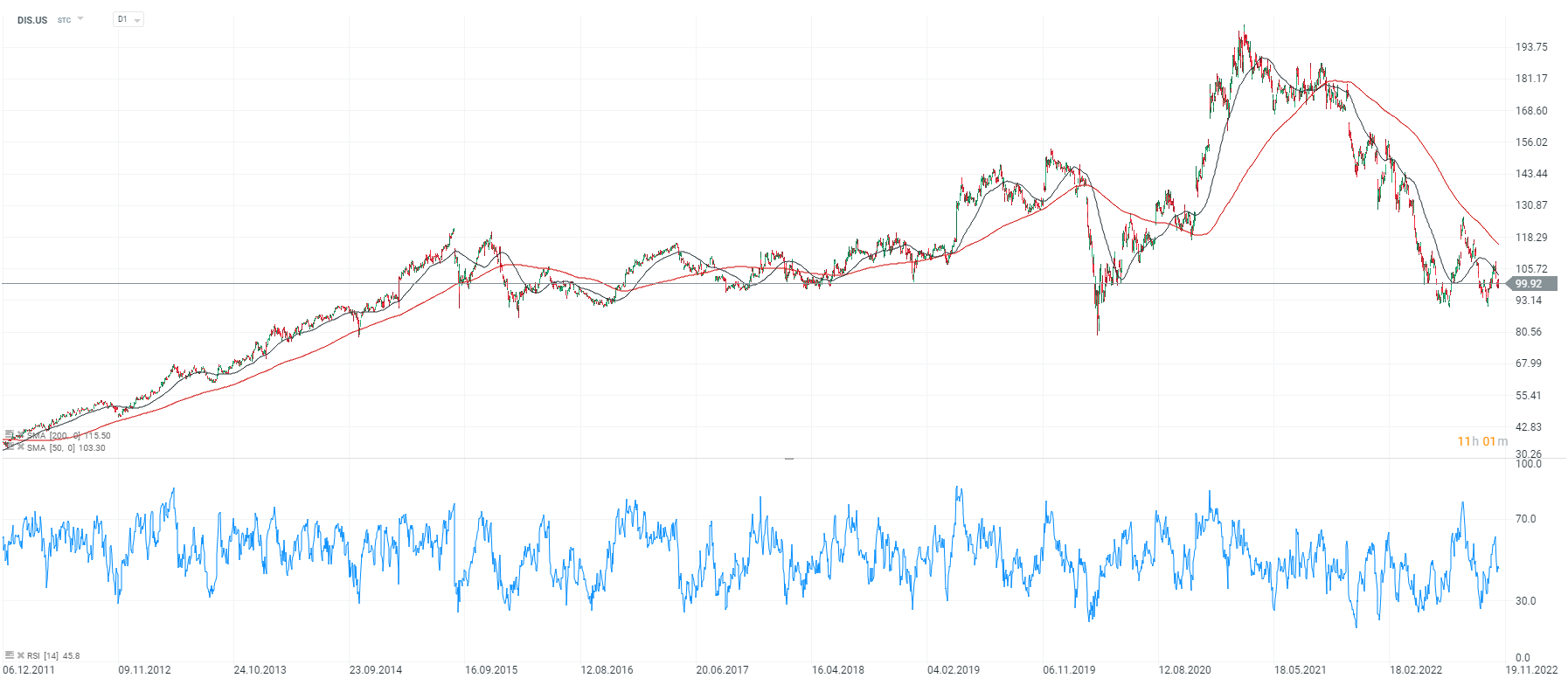Disney (DIS.US) shares are losing ahead of the Wall Street open amid lower-than-expected revenue from key business segments, rising costs and lowered forecasts. The company warned of a slowdown in the streaming business:
Revenue: $20.15 billion vs. $21.24 billion forecast (Refinitiv)
Earnings per share (EPS): $0.3 vs. $0.5 forecasts (Refinitiv)
Media and entertainment revenue: $12.7 billion (down 3% y/y) vs. $13.9 billion pronoz (StreetAccount)
Revenue from theme parks and retail operations: $7.4 billion vs. $7.5 billion forecast (StreetAccount)
Operating profit from theme parks: $818 million vs. $919 million forecasts (StreetAccount)
Total Disney+ platform subscriptions: 164.2 million vs. 160.45 million forecasts (StreetAccount)
Netflix still a long way off
The company added 12.1 million subscriptions to its Disney+ streaming platform in Q3, well above analysts' forecasts. However, Disney cooled the euphoria by announcing that it expects subscription growth to slow in the next quarter. In addition, it expects lower streaming revenue growth going forward. The Hulu platform, of which Disney is a two-thirds owner, had 47.2 million subscribers, while ESPN+ had 24.3 million.Together Disney's media holding company, i.e. Hulu, ESPN+ and Disney+, has more than 235 million streaming subscribers. Netflix, long a leader in the streaming space, had 223 million subscribers, according to data from its latest quarterly report.
Disney's streaming business, however, is still far from Netflix's margins. The Disney+ platform is still a long way from profitability, and Disney CEO Bob Chapek estimates that streaming won't reach profitability until 2024. The consumer division lost $1.47 billion and saw a 10% drop in revenue per user in the US, to $6.10. Following in Netflix's footsteps, Disney intends to consider making ads available on the platform and raising service prices. However, it is unclear how consumers will react to Disney's new streaming business policy and whether it will indeed be received as positively as it was with Netflix.
Challenging times are coming
Streaming, however, is not the only problem Wall Street has noticed for the company. Revenue from theme parks and media fell short of analysts' expectations, although Disney CEO Bob Chapek noted that it was a record high in the company's history. Performance in the theme parks and products sector (theme parks, retail business, Disney Wish cruises and resorts) showed a 34% year-over-year increase. Wall Street, however, is clearly concerned that Disney's consumer activity is likely to worsen if the economy slips into recession, the labor market weakens and inflation remains above acceptable levels. Following the bearish forecast, analysts fear that if Disney is unable to meet forecasts today, it will be even less able to do so when the US economy begins to weaken.
Disney's lower content sales were due to fewer film productions planned and created for theaters, which also means a smaller product range for the entertainment and household markets. The company conveyed that it intends to closely watch rising costs and control expenses. Disney's chief financial officer, Christine McCarthy, lowered her revenue forecast for the new fiscal year, predicting growth of less than 10% versus more than 20% in 2022. All indications are that the company will have to find a recipe to maintain revenue growth during the downturn. So far, it appears that despite its recognizable global brand, Disney's business model is experiencing problems passing costs on to consumers and is struggling to overcome the still 'high-hanging bar' set by Wall Street analysts.
Disney stock (DIS.US), D1 interval. Pre-opening trade points to an opening near $92 from where bears may try to steer the stock to yearly lows at $90. A drop below this boundary could herald a deeper sell-off although Disney shares are already experiencing massive weakness and are trading near the lows of the 2020 'covid panic'. Source: xStation5
Rivian Automotive: ดาวรุ่งหรือดาวตก? 🚗💥
DE40: ดัชนี DAX ปรับตัวขึ้น 0.5% 📈 หุ้น Lufthansa พุ่งเกือบ 5% หลังได้รับคำแนะนำเชิงบวกจาก Kepler
หุ้นเด่นรายสัปดาห์ – Jabil Inc
Broadcom (AVGO.US) หุ้นร่วง 5% แม้รายงานผลประกอบการแข็งแกร่งและความต้องการ AI สูง 🗽


